Literature mirrors the myriad experiences of women across cultures, ages, and backgrounds. The stories within its pages can empower, enlighten, and challenge perceptions, offering invaluable insights into the female experience. This blog explores 20 books that every woman should read, each offering a unique perspective on womanhood, identity, and the complexities of life.
From classics that have shaped literary history to contemporary works that resonate with today’s readers, these books are essential for anyone seeking to understand the world through women’s eyes.
Pride and Prejudice, Jane Austen
 Synopsis: Pride and Prejudice is a classic novel set in early 19th-century England. It focuses on the life and romantic misadventures of Elizabeth Bennet, the second eldest of five sisters. The novel explores the themes of love, class, and societal expectations, particularly regarding marriage.
Synopsis: Pride and Prejudice is a classic novel set in early 19th-century England. It focuses on the life and romantic misadventures of Elizabeth Bennet, the second eldest of five sisters. The novel explores the themes of love, class, and societal expectations, particularly regarding marriage.
Elizabeth’s quick wit and strong sense of independence clash with the rigid social norms of her time, especially when she encounters the wealthy and reserved Mr. Darcy. The novel examines the dangers of hasty judgments and the value of mutual respect in relationships through misunderstandings, evolving perceptions, and emotional growth. Austen’s sharp social commentary and memorable characters have made Pride and Prejudice a timeless exploration of love and personal growth.
Why should women read this? Pride and Prejudice by Jane Austen offers timeless insights into social norms, gender roles, and personal growth. The novel’s strong, witty heroine, Elizabeth Bennet, challenges societal expectations and advocates for personal integrity, independence, and the importance of mutual respect in relationships.
Through its engaging narrative and memorable characters, the book explores themes of love, marriage, class, and morality, which remain relevant today. Austen’s sharp social commentary and humor make Pride and Prejudice not just a classic romance but a powerful exploration of a woman’s quest for self-respect and fulfillment within a restrictive society.
Date of Publishing: January 28, 1813
Reading Time: Approximately 10-12 hours
The Handmaid’s Tale, by Margaret Atwood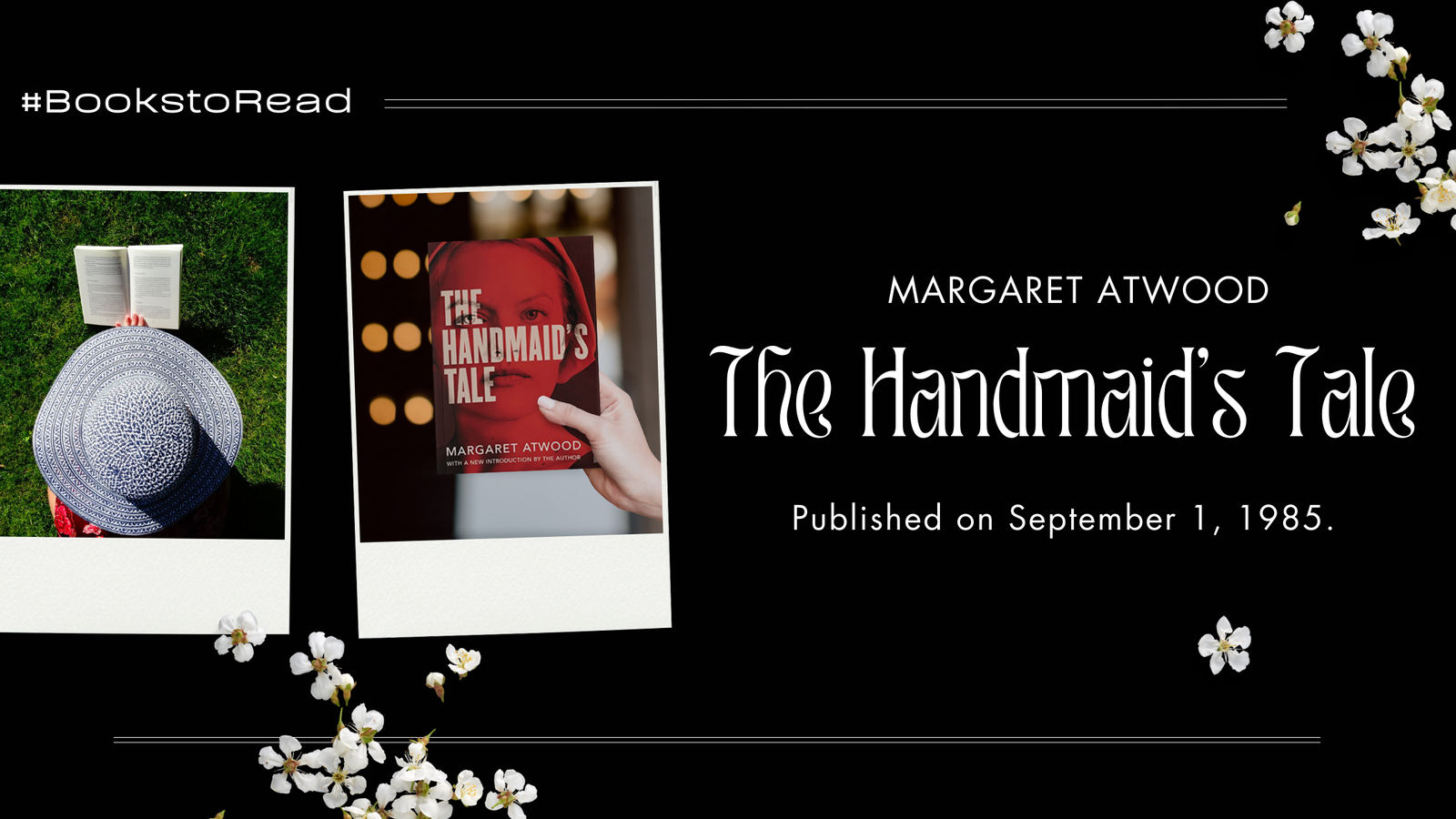
Synopsis: Set in a dystopian future, The Handmaid’s Tale takes place in the Republic of Gilead, a theocratic society that has overthrown the United States government. The novel follows Offred, a “handmaid” whose sole purpose is to bear children for the ruling class in a world plagued by infertility. Atwood’s chilling portrayal of a society that subjugates women, stripping them of their rights and identities, serves as a stark warning about the fragility of women’s autonomy.
The novel delves into themes of power, control, and resistance, exploring how language and belief systems can be manipulated to justify oppression. Through Offred’s eyes, readers are offered a harrowing glimpse into a world where women’s bodies are commodified, and their freedom is tightly controlled. The Handmaid’s Tale remains a powerful and relevant exploration of gender politics and authoritarianism.
Why should women read this? Margaret Atwood’s The Handmaid’s Tale offers a chilling exploration of totalitarianism’s dangers, women’s subjugation, and the erosion of personal freedoms. Set in a dystopian society where women’s rights are stripped away, the novel serves as a powerful commentary on gender oppression, reproductive rights, and the consequences of complacency in the face of authoritarianism.
Atwood’s portrayal of resistance and survival under oppressive conditions resonates with contemporary issues, encouraging readers to reflect on the importance of autonomy, solidarity, and the ongoing fight for gender equality. The book’s thought-provoking themes and compelling narrative make it a must-read for understanding the intersections of power, gender, and society.
Date of Publishing: September 1, 1985
Reading Time: Approximately 8-10 hours
Beloved by Toni Morrison
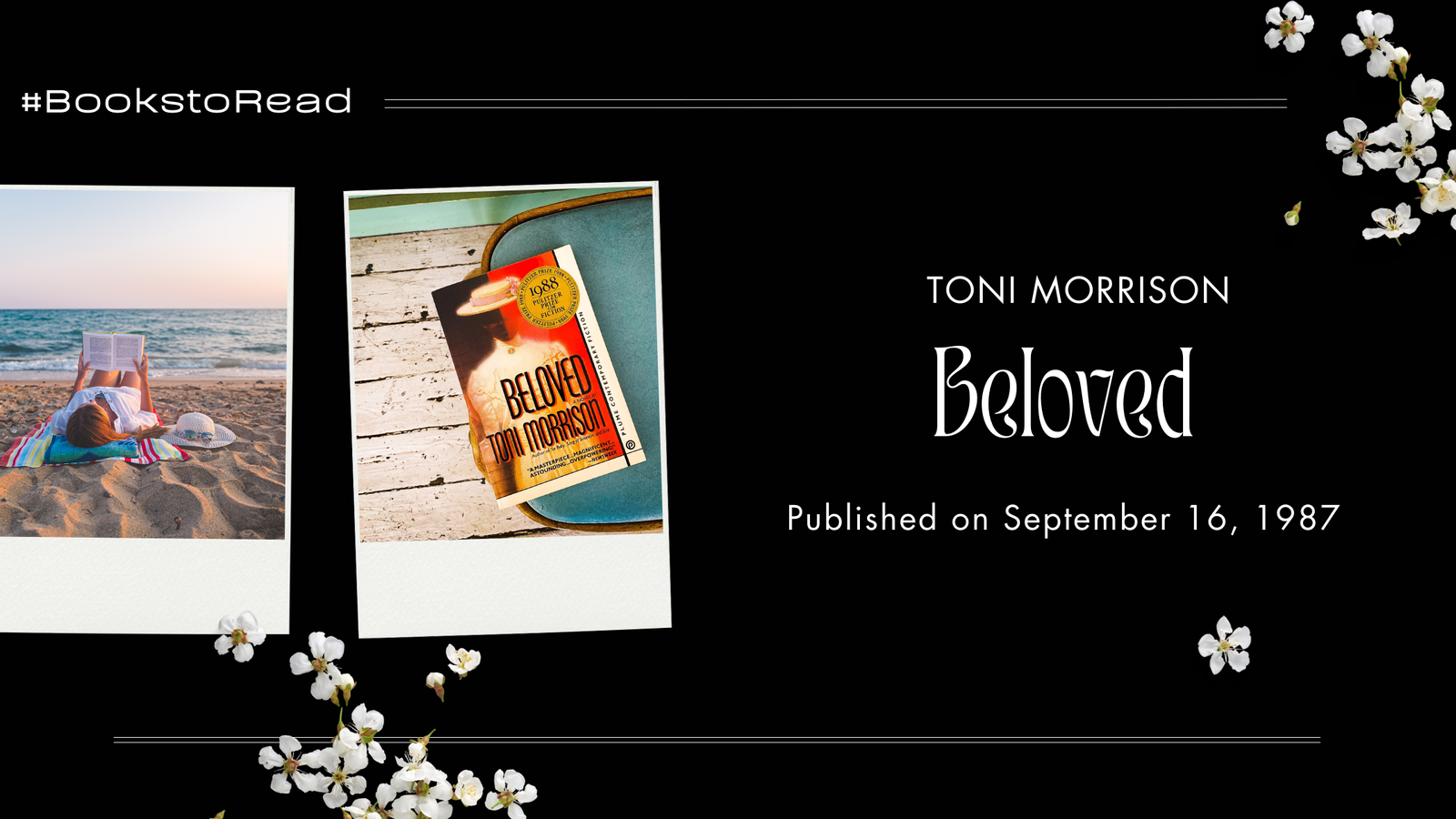 Synopsis: Beloved is a deeply haunting and lyrical novel that explores the lingering effects of slavery in post-Civil War America. The story centers on Sethe, a woman who escaped slavery but is haunted by the ghost of her deceased daughter, Beloved. Through a series of flashbacks and fragmented narratives, Morrison delves into the trauma of slavery and its devastating impact on the human spirit.
Synopsis: Beloved is a deeply haunting and lyrical novel that explores the lingering effects of slavery in post-Civil War America. The story centers on Sethe, a woman who escaped slavery but is haunted by the ghost of her deceased daughter, Beloved. Through a series of flashbacks and fragmented narratives, Morrison delves into the trauma of slavery and its devastating impact on the human spirit.
The novel examines the concepts of memory, identity, and the struggle for redemption as Sethe battles with her past and the supernatural presence that embodies her guilt and loss. Beloved is a story of personal suffering and a broader commentary on the collective memory of a brutal history that continues to shape the lives of those affected. Morrison’s powerful prose and complex characters make Beloved a profound exploration of love, loss, and the quest for identity.
Why should women read this? Beloved by Toni Morrison delves deeply into the legacy of slavery, exploring its enduring psychological and emotional impact. The novel centers on Sethe, an escaped slave haunted by her past, and addresses themes of motherhood, trauma, and the complexities of identity and freedom. Morrison’s powerful storytelling and rich, lyrical prose offer profound insights into the struggles of Black women, the bonds of family, and the quest for self-reclamation.
Beloved challenges readers to confront uncomfortable truths about history, memory, and the resilience of the human spirit, making it an essential read for understanding the depths of suffering and the strength required to overcome it.
Date of Publishing: September 16, 1987
Reading Time: Approximately 10-12 hours
The Color Purple, Alice Walker
 Synopsis: The Color Purple is a powerful and poignant novel that tells the story of Celie, an African American woman in the early 20th century who faces a life of hardship and abuse. Through letters addressed to God and later to her sister Nettie, Celie recounts her journey from oppression to self-discovery and empowerment.
Synopsis: The Color Purple is a powerful and poignant novel that tells the story of Celie, an African American woman in the early 20th century who faces a life of hardship and abuse. Through letters addressed to God and later to her sister Nettie, Celie recounts her journey from oppression to self-discovery and empowerment.
The novel explores themes of race, gender, and the struggle for autonomy in a society that marginalizes African American women. Walker’s depiction of Celie’s relationships, particularly with other women like Shug Avery and Sofia, highlights the importance of female solidarity and the transformative power of love and friendship. As Celie learns to assert her own identity and reclaim her sense of self-worth, the novel offers a profound commentary on the resilience of the human spirit and the capacity for personal growth. The Color Purple is a testament to the strength of women and the enduring power of hope and love.
Why should women read this? The Color Purple by Alice Walker offers a powerful resilience, self-discovery, and empowerment narrative. The novel tells the story of Celie, an African American woman in the early 20th century who overcomes immense abuse and oppression to find her own voice and strength.
Exploring themes like sisterhood, spirituality, and the transformative power of love, The Color Purple provides a profound commentary on race, gender, and the intersections of these identities. Walker’s compelling characters and vivid storytelling highlight marginalized women’s struggles and celebrate their ability to triumph over adversity, making it an inspiring and essential read.
Date of Publishing: October 1, 1982
Reading Time: Approximately 8-10 hours
Little Women, Louisa May Alcott
 Synopsis: Little Women is a beloved coming-of-age novel that follows the lives of the four March sisters—Meg, Jo, Beth, and Amy—as they grow up in post-Civil War America. The novel captures the trials and joys of family life, focusing on the sisters’ dreams, ambitions, and struggles as they navigate the challenges of adolescence and young adulthood. Each sister’s journey reflects different aspects of womanhood, from Meg’s desire for a traditional family life to Jo’s aspirations as a writer and her fight for independence.
Synopsis: Little Women is a beloved coming-of-age novel that follows the lives of the four March sisters—Meg, Jo, Beth, and Amy—as they grow up in post-Civil War America. The novel captures the trials and joys of family life, focusing on the sisters’ dreams, ambitions, and struggles as they navigate the challenges of adolescence and young adulthood. Each sister’s journey reflects different aspects of womanhood, from Meg’s desire for a traditional family life to Jo’s aspirations as a writer and her fight for independence.
Alcott’s portrayal of the bond between the sisters and their journey toward self-discovery resonates with readers of all ages. Through their experiences, the novel explores themes of love, duty, sacrifice, and the pursuit of personal happiness. Little Women remains a timeless classic, celebrating the strength and resilience of women and the enduring power of sisterhood.
Why should women read this? Little Women by Louisa May Alcott offers a timeless exploration of family, identity, and personal growth. The novel follows the lives of the four March sisters—Meg, Jo, Beth, and Amy—as they navigate the challenges of adolescence, love, and finding their place in the world. Each sister represents different aspects of womanhood, connecting readers with various experiences and aspirations.
Alcott’s portrayal of strong female characters who pursue their dreams, challenge societal expectations, and support one another makes Little Women an enduring celebration of sisterhood, resilience, and the complexities of growing up. It’s a story that inspires and empowers women to embrace their individuality and strength.
Date of Publishing: Little Women by Louisa May Alcott was first published in two volumes: the first on September 30, 1868, and the second on April 14, 1869.
Reading Time: Approximately 12-15 hours
Jane Eyre, Charlotte Brontë
 Synopsis: Jane Eyre is a groundbreaking novel that blends elements of gothic fiction with social critique, telling the story of an orphaned girl who overcomes adversity to find love and independence. Jane’s journey from a harsh childhood with her cruel aunt and the oppressive conditions at Lowood School to her eventual position as governess at Thornfield Hall is a tale of resilience and self-determination.
Synopsis: Jane Eyre is a groundbreaking novel that blends elements of gothic fiction with social critique, telling the story of an orphaned girl who overcomes adversity to find love and independence. Jane’s journey from a harsh childhood with her cruel aunt and the oppressive conditions at Lowood School to her eventual position as governess at Thornfield Hall is a tale of resilience and self-determination.
The novel explores themes such as morality, class, and the struggle for self-respect in Jane’s complex relationship with Mr. Rochester, her employer and later love interest. As Jane grapples with her values and desires, the novel delves into the tension between passion and reason, independence and connection. Brontë’s powerful portrayal of a woman’s fight for her identity and happiness in a restrictive society makes Jane Eyre a timeless and influential work of literature.
Why should women read this? Jane Eyre by Charlotte Brontë portrays a woman’s journey toward self-respect, independence, and moral integrity. The novel’s protagonist, Jane Eyre, is a strong, intelligent, and resilient character who defies the expectations of her time. Despite adversity, loneliness, and societal pressures, Jane remains true to herself and her principles.
The novel explores themes of love, social class, gender roles, and the struggle for autonomy, all within the context of a gothic romance. Jane Eyre challenges readers to consider the importance of self-worth and pursuing one’s path, making it a timeless and empowering read for women.
Date of Publishing: October 16, 1847
Reading Time: Approximately 12-14 hours
Their Eyes Were Watching God, Zora Neale Hurston
 Synopsis: Their Eyes Were Watching God is a seminal work of African American literature that tells the story of Janie Crawford, a woman searching for her identity and voice. Set in the early 20th century, the novel follows Janie through three marriages, each reflecting different aspects of love, power, and self-discovery.
Synopsis: Their Eyes Were Watching God is a seminal work of African American literature that tells the story of Janie Crawford, a woman searching for her identity and voice. Set in the early 20th century, the novel follows Janie through three marriages, each reflecting different aspects of love, power, and self-discovery.
Hurston’s rich and evocative prose brings to life the cultural and social landscape of the American South, exploring themes of race, gender, and the pursuit of personal freedom. Janie’s journey is one of self-empowerment as she learns to assert her desires and reject societal expectations. The novel’s exploration of the complexities of love and the struggle for autonomy resonates with readers, making it a powerful and enduring narrative about the search for self and the courage to live one’s truth.
Why should women read this? Women should read Their Eyes Were Watching God by Zora Neale Hurston because it profoundly explores a woman’s search for identity, love, and independence. The novel tells the story of Janie Crawford, a Black woman in the early 20th century, as she navigates her journey through three marriages and her quest for self-fulfillment.
Hurston’s rich, poetic language and vivid portrayal of the African American experience provide deep insights into the complexities of gender, race, and societal expectations. Janie’s resilience and determination to live on her terms make her a powerful and inspiring character. The novel encourages women to embrace their inner strength and pursue their true desires, making it a timeless and essential read.
Date of Publishing: September 18, 1937
Reading Time: Approximately 6-8 hours
A Room of One’s Own, Virginia Woolf
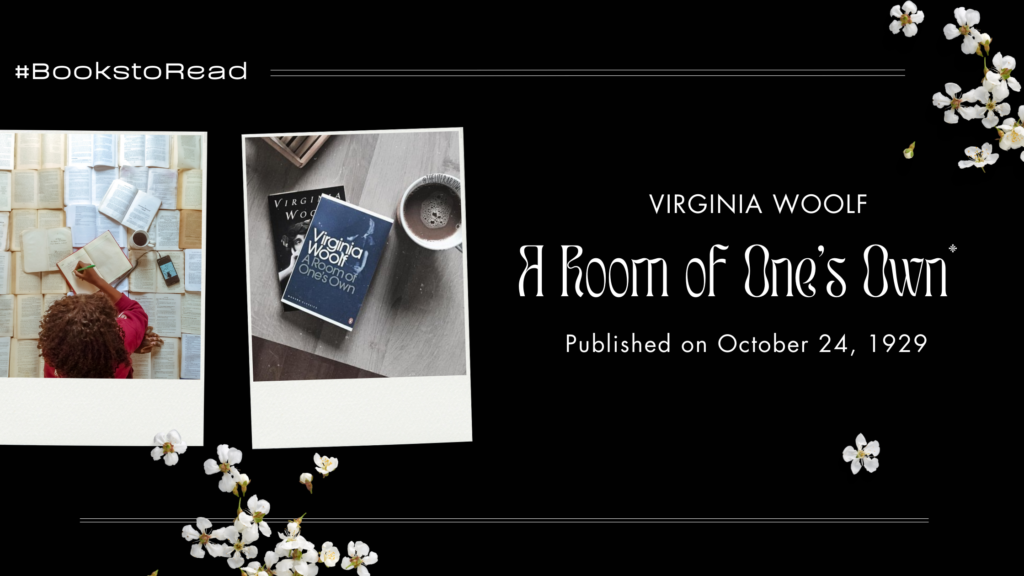 Synopsis: In A Room of One’s Own, Virginia Woolf presents a groundbreaking exploration of the role of women in literature and society. Drawing on historical and fictional examples, Woolf argues that for women to write and create, they need financial independence and a space of their own—literally and figuratively. The essay delves into the systemic barriers that have prevented women from pursuing artistic and intellectual endeavors, highlighting the disparities in education, opportunities, and societal expectations.
Synopsis: In A Room of One’s Own, Virginia Woolf presents a groundbreaking exploration of the role of women in literature and society. Drawing on historical and fictional examples, Woolf argues that for women to write and create, they need financial independence and a space of their own—literally and figuratively. The essay delves into the systemic barriers that have prevented women from pursuing artistic and intellectual endeavors, highlighting the disparities in education, opportunities, and societal expectations.
Woolf’s work is both a critique of patriarchal structures and a call to action for women to claim their space in literature and beyond. Her eloquent and thought-provoking arguments have made A Room of One’s Own a foundational text in feminist literary criticism and a must-read for anyone interested in the intersection of gender and creativity.
Why should women read this? Virginia Woolf’s A Room of One’s Own is a seminal work on the importance of financial independence and personal space for women to create and thrive. Based on a series of lectures Woolf delivered in 1928, the essay explores the challenges women have historically faced in literature and society due to gender inequality.
Woolf argues that women need literal and figurative “rooms of their own”—financial stability and creative freedom—to produce great work. The essay also delves into the societal expectations and limitations placed on women, making it a timeless reflection on gender, creativity, and the struggle for intellectual autonomy. Woolf’s insights remain relevant, inspiring women to claim their own space and voice in the world.
Date of Publishing: October 24, 1929
Reading Time: Approximately 4-5 hours
The Second Sex, Simone de Beauvoir
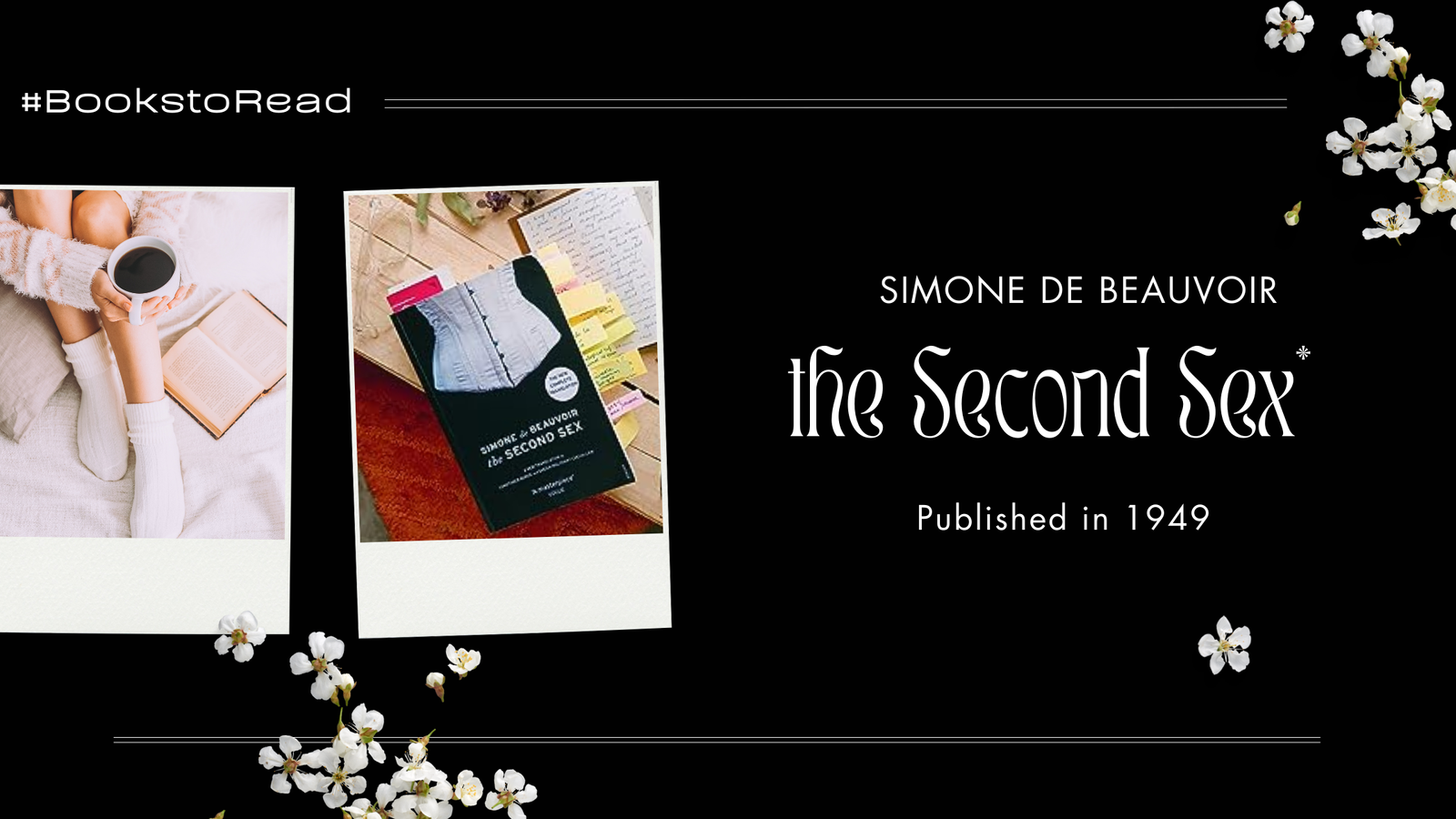 Synopsis: The Second Sex is a seminal work in feminist philosophy that examines the treatment of women throughout history and the construction of gender in society. De Beauvoir’s exhaustive analysis covers various topics, from biology and psychology to literature and economics, exploring how women have been consistently marginalized and defined as “the Other” in a male-dominated world. The book challenges traditional notions of femininity and calls for women to reject the societal roles imposed upon them.
Synopsis: The Second Sex is a seminal work in feminist philosophy that examines the treatment of women throughout history and the construction of gender in society. De Beauvoir’s exhaustive analysis covers various topics, from biology and psychology to literature and economics, exploring how women have been consistently marginalized and defined as “the Other” in a male-dominated world. The book challenges traditional notions of femininity and calls for women to reject the societal roles imposed upon them.
De Beauvoir’s work is both a critique of patriarchy and a manifesto for women’s liberation, advocating for equality and the redefinition of gender roles. The Second Sex is a dense and thought-provoking text that has profoundly impacted feminist thought and continues to be a crucial reference for understanding the dynamics of gender and power.
Why should women read this? The Second Sex by Simone de Beauvoir is a foundational text in feminist philosophy that critically examines the historical, social, and psychological constructs that have defined and oppressed women. Published in 1949, the book challenges the notion of women as “the other” and explores how society has relegated women to a secondary status.
De Beauvoir’s analysis of gender roles, identity, and the concept of “womanhood” encourages readers to question the societal norms and expectations that limit women’s freedom and potential. Addressing issues like patriarchy, sexuality, and existential freedom, The Second Sex provides a robust framework for understanding and combating gender inequality, making it an essential read for those interested in feminism and women’s rights.
Date of Publishing: 1949
Reading Time: Approximately 20-24 hours
Wild, Cheryl Strayed
 Synopsis: Wild is a raw and introspective memoir that recounts Cheryl Strayed’s journey of self-discovery and healing as she hikes the Pacific Crest Trail alone. Following the death of her mother and the dissolution of her marriage, Strayed embarks on a physically demanding and emotionally challenging trek that spans over a thousand miles. Along the way, she confronts her grief, past mistakes, and the deep sense of loss that has shaped her life.
Synopsis: Wild is a raw and introspective memoir that recounts Cheryl Strayed’s journey of self-discovery and healing as she hikes the Pacific Crest Trail alone. Following the death of her mother and the dissolution of her marriage, Strayed embarks on a physically demanding and emotionally challenging trek that spans over a thousand miles. Along the way, she confronts her grief, past mistakes, and the deep sense of loss that has shaped her life.
Strayed’s narrative is both a literal and metaphorical journey, exploring themes of resilience, redemption, and the transformative power of nature. Her honest and unflinching portrayal of her struggles, combined with the breathtaking descriptions of the wilderness, makes Wild an inspiring and moving tale of personal growth and the search for meaning in the face of adversity.
Why should women read this? Women should read Wild by Cheryl Strayed because it offers an inspiring and raw account of personal transformation, resilience, and healing. The memoir recounts Strayed’s solo hike along the Pacific Crest Trail after a series of personal tragedies, including the death of her mother and the dissolution of her marriage. Through her physical journey, Strayed confronts her grief, pain, and mistakes, ultimately finding strength and clarity.
Wild resonates with many women because it explores themes of self-discovery, empowerment, and confronting one’s fears and vulnerabilities. Strayed’s honest and unflinching narrative encourages readers to embrace their growth journeys and find courage in adversity.
Date of Publishing: March 20, 2012
Reading Time: Approximately 7-9 hours
I Know Why the Caged Bird Sings, Maya Angelou
 Synopsis: I Know Why the Caged Bird Sings is the first in a series of autobiographies by Maya Angelou, chronicling her early life in the segregated American South. The memoir explores themes of identity, racism, and the search for personal freedom as Angelou recounts her experiences growing up in a world that consistently devalues her worth as a Black woman. Through her vivid and poignant storytelling, Angelou paints a powerful picture of the challenges she faced, including her struggle with self-esteem and the trauma of sexual abuse.
Synopsis: I Know Why the Caged Bird Sings is the first in a series of autobiographies by Maya Angelou, chronicling her early life in the segregated American South. The memoir explores themes of identity, racism, and the search for personal freedom as Angelou recounts her experiences growing up in a world that consistently devalues her worth as a Black woman. Through her vivid and poignant storytelling, Angelou paints a powerful picture of the challenges she faced, including her struggle with self-esteem and the trauma of sexual abuse.
The memoir is a testament to the resilience of the human spirit and the importance of finding one’s voice in a world that seeks to silence it. Angelou’s eloquent prose and unflinching honesty make I Know Why the Caged Bird Sings an essential read for understanding the complexities of race, gender, and the pursuit of self-acceptance.
Why should women read this? I Know Why the Caged Bird Sings by Maya Angelou is a powerful autobiographical account of overcoming adversity and finding one’s voice. The book details Angelou’s childhood and early adulthood, exploring themes of racism, trauma, and resilience. Through her poignant and poetic narrative, Angelou shares her experiences of growing up in the segregated South, dealing with personal and societal challenges, and ultimately discovering her strength and self-worth.
I Know Why the Caged Bird Sings offers profound insights into identity, empowerment, and the transformative power of literature and self-expression. It is a compelling and inspirational read for women seeking to understand and embrace their stories.
Date of Publishing: September 25, 1969
Reading Time: Approximately 7-8 hours
The Feminine Mystique, Betty Friedan
 Synopsis: The Feminine Mystique is a landmark work in feminist literature credited with sparking the second-wave feminist movement in the United States. Friedan’s book challenges the idealized image of women as housewives and mothers, arguing that this narrow role leads to dissatisfaction and unfulfillment for many women. Drawing on interviews, research, and personal experiences, Friedan explores the “problem that has no name”—the widespread unhappiness among women confined by societal expectations.
Synopsis: The Feminine Mystique is a landmark work in feminist literature credited with sparking the second-wave feminist movement in the United States. Friedan’s book challenges the idealized image of women as housewives and mothers, arguing that this narrow role leads to dissatisfaction and unfulfillment for many women. Drawing on interviews, research, and personal experiences, Friedan explores the “problem that has no name”—the widespread unhappiness among women confined by societal expectations.
The book critiques the cultural and institutional forces perpetuating these roles and calls for women to pursue education, careers, and personal growth outside the domestic sphere. The Feminine Mystique remains a crucial text for understanding the evolution of feminist thought and the ongoing struggle for gender equality.
Why should women read this? Betty Friedan’s The Feminine Mystique is a groundbreaking work that sparked the second wave of feminism in the 1960s. The book critically examines the widespread dissatisfaction among suburban housewives, highlighting the limitations and discontent that stemmed from traditional gender roles and the societal expectation that women find fulfillment solely through marriage and domesticity.
Friedan’s analysis of the “feminine mystique” reveals how these roles stifled women’s potential and aspirations. By addressing issues of identity, autonomy, and societal expectations, the book remains crucial for understanding the ongoing struggles for gender equality and women’s empowerment, encouraging readers to question and challenge restrictive norms.
Date of Publishing: February 19, 1963
Reading Time: Approximately 10-12 hours
The Bell Jar, Sylvia Plath
 Synopsis: The Bell Jar is a semi-autobiographical novel that explores the life of Esther Greenwood, a young woman grappling with her mental health in the 1950s. The novel delves into Esther’s internal struggle as she navigates societal expectations, her career aspirations, and her growing sense of alienation. Plath’s portrayal of Esther’s descent into depression is both poignant and unsettling, capturing the complexities of mental illness with raw honesty.
Synopsis: The Bell Jar is a semi-autobiographical novel that explores the life of Esther Greenwood, a young woman grappling with her mental health in the 1950s. The novel delves into Esther’s internal struggle as she navigates societal expectations, her career aspirations, and her growing sense of alienation. Plath’s portrayal of Esther’s descent into depression is both poignant and unsettling, capturing the complexities of mental illness with raw honesty.
The novel explores themes of identity, femininity, and the pressure to conform to societal norms, offering a stark critique of the limitations placed on women in a male-dominated world. The Bell Jar is a powerful exploration of the fragility of the human mind and the struggle for autonomy and self-expression in a world that often stifles individuality.
Why should women read this? The Bell Jar by Sylvia Plath offers a powerful and introspective exploration of mental illness, identity, and societal pressures. The novel, a semi-autobiographical account, follows Esther Greenwood’s struggle with depression and her quest for self-identity in the face of societal expectations. Plath’s poignant and evocative writing provides deep insights into the psychological challenges women face and the impact of societal norms on personal well-being.
The Bell Jar is both a profound commentary on the constraints imposed on women and a compelling narrative of personal resilience, making it an essential read for understanding the complexities of mental health and the pursuit of autonomy.
Date of Publishing: January 14, 1963
Reading Time: Approximately 6-8 hours
The Joy Luck Club, Amy Tan
 Synopsis: The Joy Luck Club is a novel that explores the lives of four Chinese-American immigrant families in San Francisco, focusing on the complex relationships between mothers and daughters. The novel is structured around the stories of eight women, divided into four pairs of mothers and daughters, each narrating their experiences of cultural conflict, generational differences, and the search for identity.
Synopsis: The Joy Luck Club is a novel that explores the lives of four Chinese-American immigrant families in San Francisco, focusing on the complex relationships between mothers and daughters. The novel is structured around the stories of eight women, divided into four pairs of mothers and daughters, each narrating their experiences of cultural conflict, generational differences, and the search for identity.
Tan’s exploration of the immigrant experience and the struggle to balance traditional Chinese values with American culture resonates deeply with readers. The novel delves into themes of sacrifice, love, and the unspoken bonds that connect mothers and daughters, even across cultural and generational divides. The Joy Luck Club is a rich and moving narrative that captures family life’s complexities and cultural heritage’s enduring power.
Why should women read this? The Joy Luck Club by Amy Tan provides a rich exploration of the experiences and struggles of Chinese American women across generations. The novel weaves together the stories of four Chinese American immigrant families and their daughters, highlighting themes of cultural identity, generational conflict, and the complex dynamics of mother-daughter relationships.
Through its multi-layered narrative, The Joy Luck Club addresses issues of assimilation, cultural heritage, and personal growth, offering valuable insights into the immigrant experience and the impact of cultural expectations on women’s lives. Tan’s compassionate and nuanced portrayal of these characters encourages readers to reflect on their family histories and the influence of cultural heritage on personal identity.
Date of Publishing: June 22, 1989
Reading Time: Approximately 8-10 hours
Eat, Pray, Love, Elizabeth Gilbert
 Synopsis: Eat, Pray, Love is a memoir chronicling Elizabeth Gilbert’s year-long journey of self-discovery and healing after a painful divorce. Divided into three sections, the book follows Gilbert as she travels to Italy, India, and Indonesia, seeking pleasure, spirituality, and balance in her life. In Italy, she indulges in the sensory pleasures of food and culture, finding solace in the simple joys of life.
Synopsis: Eat, Pray, Love is a memoir chronicling Elizabeth Gilbert’s year-long journey of self-discovery and healing after a painful divorce. Divided into three sections, the book follows Gilbert as she travels to Italy, India, and Indonesia, seeking pleasure, spirituality, and balance in her life. In Italy, she indulges in the sensory pleasures of food and culture, finding solace in the simple joys of life.
In India, she immerses herself in meditation and spiritual practice, confronting her inner demons and seeking a deeper connection to the divine. In Indonesia, she strives to find balance and open herself to love again. Gilbert’s candid and reflective writing captures the universal quest for meaning and fulfillment, making Eat, Pray, Love an inspiring and relatable journey of self-discovery and personal growth.
Why should women read this? Eat, Pray, Love by Elizabeth Gilbert is a compelling memoir about self-discovery, healing, and personal growth. The book chronicles Gilbert’s year-long journey through Italy, India, and Indonesia following a divorce as she seeks to reclaim her sense of self and find meaning and fulfillment.
Through her experiences with food, spirituality, and love, Gilbert explores themes of identity, transformation, and the pursuit of happiness. Eat, Pray, Love inspires and encourages women to embark on their journeys of self-exploration and healing, making it a relatable and uplifting read for those seeking to navigate life’s challenges and rediscover their passions.
Date of Publishing: February 16, 2006
Reading Time: Approximately 6-8 hours
The Immortal Life of Henrietta Lacks, Rebecca Skloot
 Synopsis: The Immortal Life of Henrietta Lacks is a compelling non-fiction book that tells the story of Henrietta Lacks, a Black woman whose cancer cells were taken without her consent in 1951 and became one of the most essential tools in medical research. Skloot’s narrative weaves together the scientific significance of HeLa cells with the human story behind them, exploring the ethical implications of medical research and the exploitation of marginalized communities.
Synopsis: The Immortal Life of Henrietta Lacks is a compelling non-fiction book that tells the story of Henrietta Lacks, a Black woman whose cancer cells were taken without her consent in 1951 and became one of the most essential tools in medical research. Skloot’s narrative weaves together the scientific significance of HeLa cells with the human story behind them, exploring the ethical implications of medical research and the exploitation of marginalized communities.
The book delves into the impact of Henrietta’s cells on her family, who were unaware of their mother’s contributions to science for decades, and the broader questions of consent, privacy, and the commodification of human tissue. The Immortal Life of Henrietta Lacks is a thought-provoking and eye-opening exploration of the intersection of science, ethics, and human rights, offering a powerful commentary on the legacy of exploitation in medical research.
Why should women read this? Rebecca Skloot’s The Immortal Life of Henrietta Lacks intertwines scientific history with a poignant personal narrative, highlighting issues of ethics, race, and medical exploitation. The book tells the story of Henrietta Lacks, whose cancer cells were taken without her knowledge in the 1950s and became one of the most essential tools in medical research.
Through her cells, known as HeLa cells, Skloot explores the profound impact on scientific advancement while addressing the ethical and human rights issues involved. The narrative provides a compelling look at the intersection of science, race, and personal dignity, offering essential insights into how women’s lives and contributions have been recognized and valued in the medical field.
Date of Publishing: February 2, 2010
Reading Time: Approximately 10-12 hours
The Goldfinch, Donna Tartt
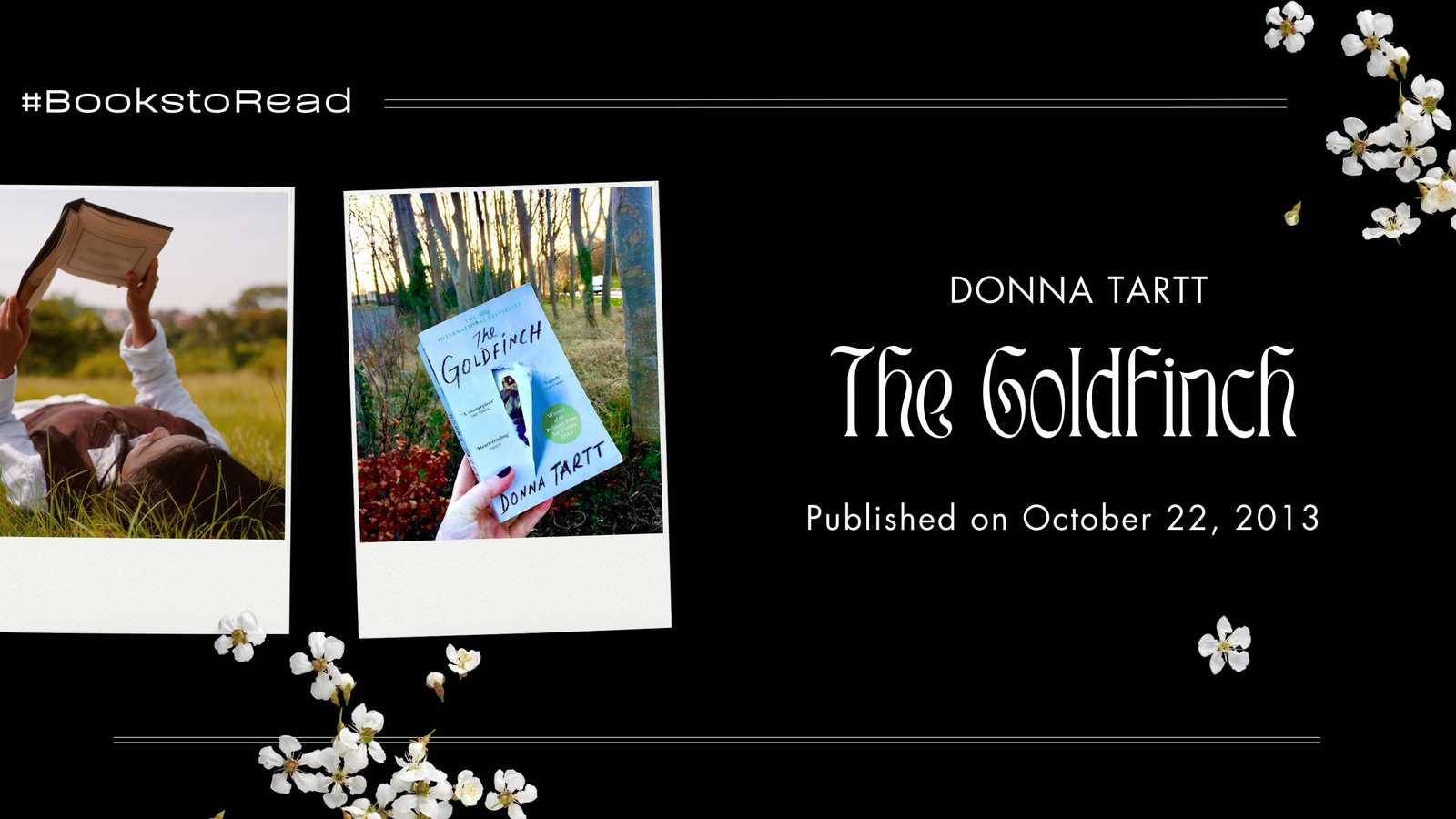 Synopsis: The Goldfinch is a Pulitzer Prize-winning novel that follows the life of Theo Decker, a young boy who survives a terrorist bombing at a museum that kills his mother. In the aftermath of the tragedy, Theo is drawn into the world of art and crime, clinging to a miniature painting called The Goldfinch, which becomes his obsession and a symbol of his loss. Tartt’s novel is a richly detailed exploration of grief, identity, and the search for meaning in a chaotic world.
Synopsis: The Goldfinch is a Pulitzer Prize-winning novel that follows the life of Theo Decker, a young boy who survives a terrorist bombing at a museum that kills his mother. In the aftermath of the tragedy, Theo is drawn into the world of art and crime, clinging to a miniature painting called The Goldfinch, which becomes his obsession and a symbol of his loss. Tartt’s novel is a richly detailed exploration of grief, identity, and the search for meaning in a chaotic world.
Through Theo’s experiences, the novel delves into the complexities of human relationships, trauma’s impact, and art’s enduring power. The Goldfinch is a sweeping and immersive narrative that captures the beauty and darkness of life, offering a profound meditation on how we cope with loss and seek redemption.
Why should women read this? Donna Tartt’s The Goldfinch is a richly detailed and emotionally resonant story about art, loss, and personal growth. The novel follows Theo Decker, who survives a terrorist attack at a museum that takes his mother’s life and leaves him in possession of a priceless painting. Through Theo’s journey from adolescence to adulthood, Tartt explores themes of trauma, identity, and the redemptive power of art.
The book’s intricate narrative and well-developed characters provide a deep, immersive experience that resonates with readers navigating their struggles and searching for meaning. The Goldfinch offers a gripping story and a thoughtful reflection on the complexities of life and human connections.
Date of Publishing: October 22, 2013
Reading Time: Approximately 20-22 hours
Bad Feminist, Roxane Gay
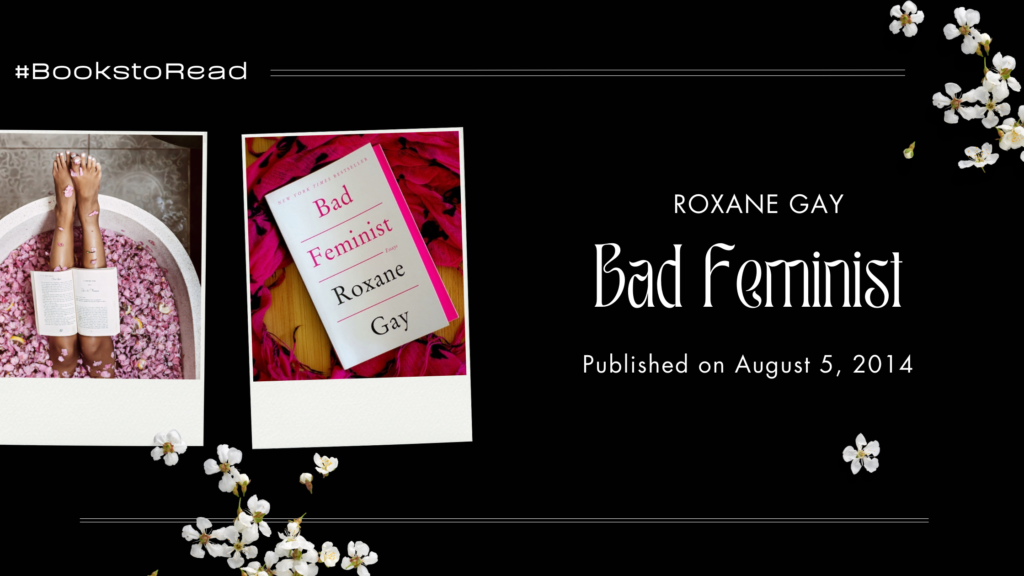 Synopsis: Bad Feminist is a collection of essays by Roxane Gay that tackles issues of race, gender, and culture with humor, insight, and unapologetic honesty. Gay’s essays cover many topics, from pop culture and politics to personal experiences, offering a nuanced and often contradictory perspective on what it means to be a feminist in the modern world. The book’s title reflects Gay’s recognition of her imperfections and the complexities of navigating feminist ideals in a world that is far from perfect.
Synopsis: Bad Feminist is a collection of essays by Roxane Gay that tackles issues of race, gender, and culture with humor, insight, and unapologetic honesty. Gay’s essays cover many topics, from pop culture and politics to personal experiences, offering a nuanced and often contradictory perspective on what it means to be a feminist in the modern world. The book’s title reflects Gay’s recognition of her imperfections and the complexities of navigating feminist ideals in a world that is far from perfect.
Through her candid and thought-provoking writing, Gay challenges readers to rethink their assumptions about feminism, identity, and how we navigate our flaws and contradictions. Bad Feminist is a refreshing and relatable exploration of the challenges and contradictions of a feminist life in a complex and ever-changing world.
Why should women read this? Women should read Bad Feminist by Roxane Gay because it offers a candid and thought-provoking exploration of feminism, identity, and cultural criticism. Through a collection of essays, Gay addresses the complexities of being a feminist in a world full of contradictions, and she challenges readers to embrace the messy, imperfect nature of activism and personal beliefs.
Her writing delves into issues like race, gender, and pop culture with humor and insight, making it accessible and engaging. Bad Feminist encourages readers to reflect on their views, engage in critical discussions about social justice, and appreciate the diverse experiences and perspectives that shape modern feminism.
Date of Publishing: August 5, 2014
Reading Time: Approximately 6-8 hours
Becoming, Michelle Obama
 Synopsis: Becoming is the memoir of Michelle Obama, the former First Lady of the United States. In it, she reflects on her life, from her childhood on the South Side of Chicago to her years in the White House. The book offers an intimate and candid look at her challenges and triumphs as she navigated the pressures of public life, motherhood, and her career.
Synopsis: Becoming is the memoir of Michelle Obama, the former First Lady of the United States. In it, she reflects on her life, from her childhood on the South Side of Chicago to her years in the White House. The book offers an intimate and candid look at her challenges and triumphs as she navigated the pressures of public life, motherhood, and her career.
Obama’s narrative is both personal and inspiring. She shares her journey of self-discovery, her commitment to social issues, and her efforts to balance family life with her role as a public figure. Becoming is a powerful and uplifting story of resilience, determination, and the pursuit of one’s true self, offering readers a glimpse into the life of one of the most influential women of our time.
Why should women read this? Becoming by Michelle Obama offers an inspiring and intimate look into the life and journey of a remarkable woman. The memoir traces Obama’s experiences from her childhood on the South Side of Chicago to her role as First Lady of the United States. Through candid reflections and personal anecdotes, Obama shares her struggles, triumphs, and the lessons she’s learned along the way.
Becoming provides valuable insights into the challenges of balancing career, family, and public life. It serves as a powerful reminder of the importance of perseverance, self-discovery, and pursuing one’s path. The book is both motivational and relatable, encouraging women to embrace their stories and aspirations.
Date of Publishing: November 13, 2018
Reading Time: Approximately 10-12 hours
Homegoing, Yaa Gyasi
 Synopsis: Homegoing is a multi-generational saga that traces the divergent paths of two half-sisters and their descendants from 18th-century Ghana to modern-day America. The novel begins with the story of Effia and Esi, two sisters who are separated by the slave trade—one is married off to a British colonizer, while the other is sold into slavery. Each subsequent chapter follows a descendant of these sisters, exploring the legacy of slavery, colonialism, and systemic racism.
Synopsis: Homegoing is a multi-generational saga that traces the divergent paths of two half-sisters and their descendants from 18th-century Ghana to modern-day America. The novel begins with the story of Effia and Esi, two sisters who are separated by the slave trade—one is married off to a British colonizer, while the other is sold into slavery. Each subsequent chapter follows a descendant of these sisters, exploring the legacy of slavery, colonialism, and systemic racism.
Gyasi’s narrative weaves together the personal and the historical, creating a rich tapestry of interconnected stories that highlight the enduring impact of historical trauma on individuals and families. Homegoing is a powerful exploration of identity, heritage, and how the past shapes the present, offering a profound meditation on the complexities of the African diaspora.
Why should women read this? Women should read Homegoing by Yaa Gyasi because it offers a powerful and expansive narrative that explores the lasting impact of slavery on generations of families. The novel traces the parallel lives and descendants of two half-sisters in 18th-century Ghana—one sold into slavery and the other married to a British slaver. Through its intergenerational storytelling,
Homegoing addresses themes of identity, resilience, and the enduring effects of historical trauma. Gyasi’s vivid and compelling prose brings to life the personal and collective struggles Black women face across different eras and geographies. The novel provides important insights into how history shapes our present, making it a profound and essential read for understanding the complexities of heritage, culture, and the human experience.
Date of Publishing: June 7, 2016.
Reading Time: Approximately 8-10 hours
The above books offer a diverse and enriching exploration of the female experience across different cultures, periods, and perspectives. From the classics that have shaped literary history to contemporary works that address the challenges and triumphs of modern womanhood, each book on this list provides valuable insights into the complexities of being a woman in a constantly evolving world.
Whether you’re seeking stories of resilience, empowerment, or self-discovery, these books are essential reads that will resonate with women of all ages and backgrounds. Dive into these narratives and let them inspire, challenge, and uplift you on your journey of understanding and growth.


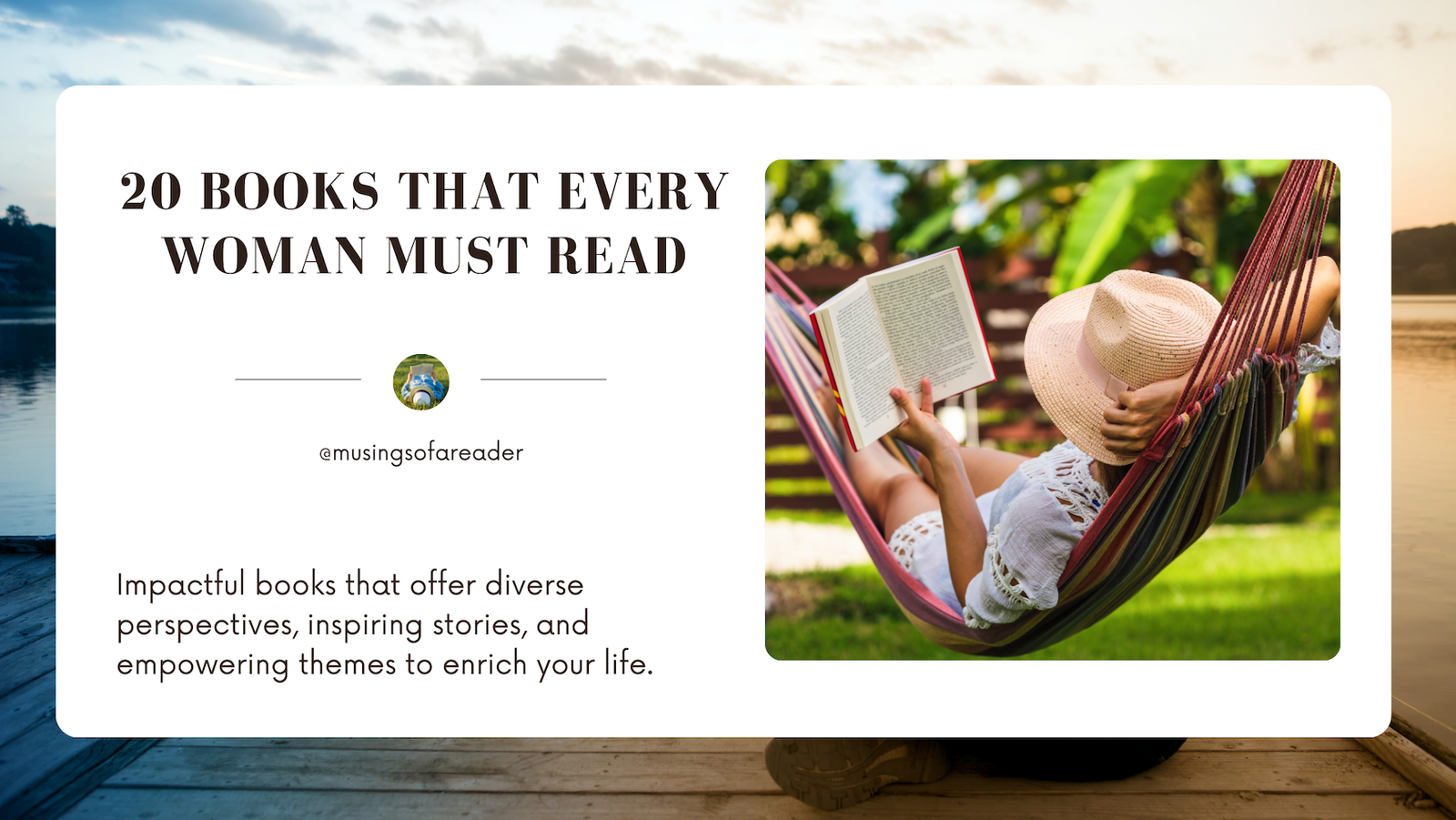
There are no reviews yet.